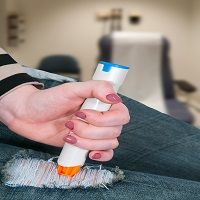Article
New Recommendations for Treating Anaphylaxis and Other Allergic Reactions
Author(s):
Recent studies of anaphylaxis and other allergic reactions induced by medications have informed a new set of guidelines for the diagnosis and treatment drug hypersensitivity.
Recent studies of anaphylaxis and other allergic reactions induced by medications have informed a new set of guidelines for the diagnosis and treatment drug hypersensitivity.
The recommendations — which have been endorsed by the German Society for Allergology and Clinical Immunology, along with 9 other Western European medical groups — urge physicians to learn which symptoms may indicate allergic reactions and to follow up with formal tests that can save lives.

“All cases of suspected hypersensitivity reactions associated with the use of drugs in any age group should undergo diagnostic investigation with the aim of identifying the trigger and possibly the underlying pathomechanism, assessing the patient’s risk for further reactions, and advising the patient accordingly on this risk,” the guideline authors in Allergo Journal International.
“Dispensing with a diagnostic work-up can result in severe reactions on renewed exposure on the one hand, and to unjustified restrictions in terms of treatment options on the other.”
In most cases, allergists or immunologists should be the ones to test patients for allergies and to formally diagnose any problems those diagnostics uncover. That said, the guidelines recommend that all physicians learn when to refer patients to specialists and how to treat emergencies such as anaphylaxis.
Doctors should routinely review materials that help them spot the symptoms of drug hypersensitivity and teach them which medications tend to produce which reactions. Such efforts will not only help caregivers distinguish true allergic reactions from other problems but also, in cases where allergies seem probable, help caregivers determine the likely precipitant.
“The diagnostic success rate is higher in patients presenting during the acute phase of a reaction, since it is possible at that point to establish differential diagnoses, classify clinical manifestations, and reliably interpret the course of symptoms in relation to drug use. Creating a timeline diagram is recommended in cases where multiple drugs are taken,” write the guideline authors, who include a table with typical time intervals between drug intake and various symptoms.
“Although information provided by the patient, as well as all available medical records relating to the reaction (eg, discharge letter, medical chart, anesthetic chart) need to be consulted, these are sometimes unreliable.”
The guidelines recommend that diagnosis of allergies begin with some combination of skin tests and blood tests. They note, however, that such tests are often inconclusive in the case of medication allergies and recommend, in such cases, that specialists consider challenging patients with whatever medications may be triggering reactions.
There are, of course, some risks to such a strategy, but the guideline authors write that a number of studies demonstrate that, in carefully controlled conditions, the benefits often outweigh the risks.
“Particularly in the case of suspected reactions to substances in drug groups that are essential or that cannot be permanently avoided (eg, analgesics, antibiotics, local anesthetics), provocation tests also serve to identify tolerated drugs (alternative preparations in the case of possible drug cross-reactivity),” they note.
“The patient should be informed about the goal of diagnostic testing, the risks involved, the alternatives, as well as the test procedure, including the use of placebo. Informed consent should be given in writing.”





